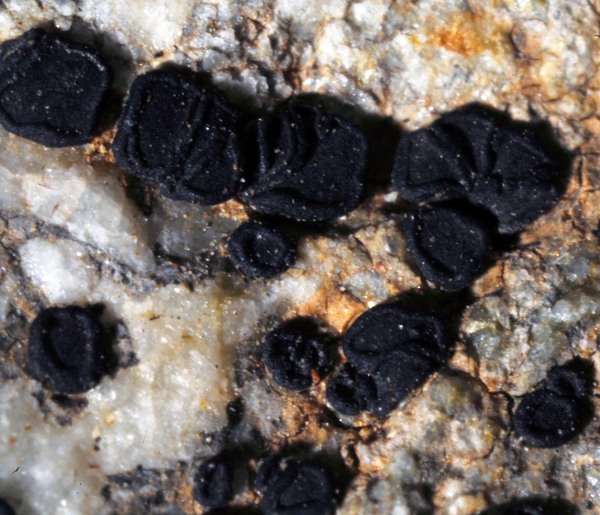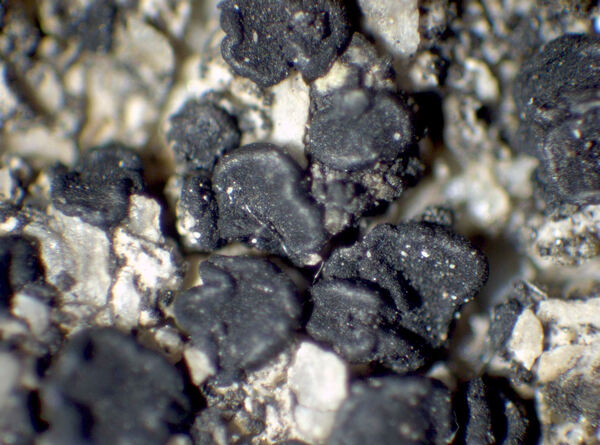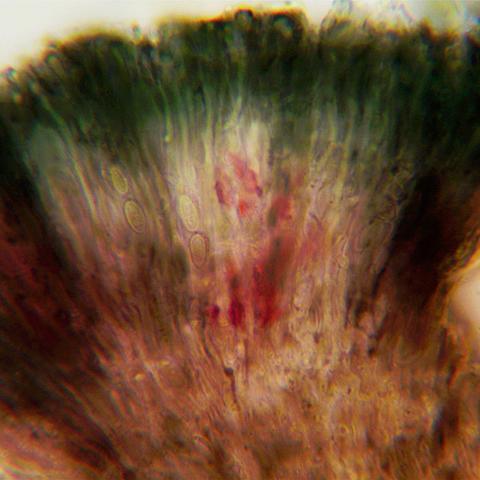Adelolecia pilati (Hepp) Hertel & Hafellner
in Hafellner, Beih. Nova Hedwigia, 79: 260, 1984. Basionym: Biatora pilati Hepp - Flecht. Eur.: nr. 261, 1857.
Synonyms: Buellia modicula (Nyl.) Dalla Torre & Sarnth.; Lecidea auriculata var. hardangeriana Vain.; Lecidea chrysotheicha Nyl.; Lecidea lyngeana Zahlbr.; Lecidea modicula Nyl.; Lecidea pilati (Hepp) Körb.; Lecidea proludens Nyl.; Lecidea subauriculata Lynge nom. illegit. non B. de Lesd.; Lecidea tirolica Vain.; Lecidella botryosa Hepp ex Arnold; Lecidella proludens (Nyl.) Arnold
Distribution: N - Frl (Tretiach & Hafellner 2000), Ven, TAA (Arnold Lich. Exs. 805b, type of L. tirolica: Hertel & Rambold 1995, Caniglia & al. 2002, Hafellner 2006, Nascimbene & al. 2022), Lomb (Hertel & Rambold 1995), Piem (Isocrono & al. 2003), VA (Piervittori & Isocrono 1999), Lig (TSB 33433). C - Tosc. S - Cal (Hertel & Rambold 1995, Puntillo 1996).
Description: Thallus crustose, endosubstratic to thinly episubstratic and then of contiguous to dispersed granules or areoles, grey to whitish, without a distinct prothallus. Medulla white, I-. Apothecia lecideine, black, 0,5-1.5(-3) mm across, rounded or angular by mutual compression, sometimes aggregated into larger units, constricted at base, with a flat to finally irregularly convex, epruinose disc, and a usually sinuous, finally sometimes excluded proper margin. Proper exciple of radially arranged hyphae, the outer rim thick, blackish green or blackish brown, the inner part golden brown and K+ strongly magenta (solution), C+ brown-red; epithecium bright green, green-black to green-brown in older apothecia, K-, N+ purple; hymenium very pale blue-green, 30-60(-75) µm high, I+ blue; paraphyses strongly coherent, simple or sparingly branched in upper part, the apical cell to 5 µm wide; hypothecium colourless to pale brown, with granules reacting K+ magenta. Asci 8-spored, clavate, with a K/I+ blue apical dome penetrated by a narrow, K/I- apical cushion surrounded by a narrow, deeply K/I+ blue zone, the wall K/I- but surrounded by an I+ red-brown, K/I+ blue outer layer, the ocular chamber relatively small, Biatora-type. Ascospores 1-celled, hyaline, narrowly ellipsoid, (6-)7-10(-13) x 3-4.5(-5.5) µm. Pycnidia dark, immersed. Conidia bacilliform. Photobiont chlorococcoid. Spot tests: thallus K-, C-, KC- or KC+ pink, P-, UV-. Chemistry: thallus with an unidentified compound or without lichen substances; apothecia with 7-chloroemodin.Note: an arctic-alpine, circumpolar species of steeply inclined to rain-sheltered surfaces of weathered, metal-rich metamorphic rocks seldom wetted by rain, from the subalpine to the nival belt; widespread in the Alps and also occurring in the high Mediterranean mountains. For further details see Hertel & Rambold (1995).
Growth form: Crustose
Substrata: rocks
Photobiont: green algae other than Trentepohlia
Reproductive strategy: mainly sexual
In underhangs rarely wetted by rain
Species of metal-rich rocks
Commonnes-rarity: (info)
Alpine belt: rather rare
Subalpine belt: rare
Oromediterranean belt: very rare
Montane belt: extremely rare
Submediterranean belt: absent
Padanian area: absent
Humid submediterranean belt: absent
Humid mediterranean belt: absent
Dry mediterranean belt: absent

Predictive model
Herbarium samples
Growth form: Crustose
Substrata: rocks
Photobiont: green algae other than Trentepohlia
Reproductive strategy: mainly sexual
In underhangs rarely wetted by rain
Species of metal-rich rocks
Commonnes-rarity: (info)
Alpine belt: rather rare
Subalpine belt: rare
Oromediterranean belt: very rare
Montane belt: extremely rare
Submediterranean belt: absent
Padanian area: absent
Humid submediterranean belt: absent
Humid mediterranean belt: absent
Dry mediterranean belt: absent

Predictive model
| Herbarium samples |
 INDEX FUNGORUM
INDEX FUNGORUM
 GBIF
GBIF
 DOLICHENS
DOLICHENS






